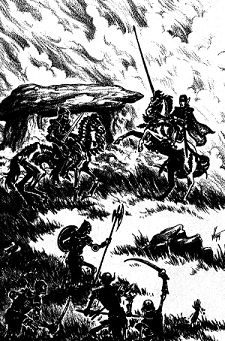Few merchants, rangers, shepherds, and guides claim to know every rolling hill or ravine in the vast grasslands known as the Fields of the Dead and called wryly by some: “A tenday ride that starts halfway to anywhere, and ends up halfway to anywhere”. Fewer still really know their way around the seemingly endless open lands where every grassy slope looks just like the next and small rock outcrops, crags, and stands of trees serve as major landmarks. The bards sing that every second hill is built of the heaped bodies of the fallen, and they’re not very far wrong.
The Fields are named for their recurring use as a battleground: first between humans from warmer lands invading the territories of nomadic gnoll, goblin, and orc tribes; later between Calinutse factions vying for access to the resource-rich North; and still later between proud and expansionist Calinutse and human settlements struggling (successfully, thus far) to retain their independence. Thousands upon thousands of skirmishes have occurred in these largely trackless hills, from a few brigands or kobolds trying to raid the livestock of traveling drovers up to clashes between hosts of knights in full armor, each side filling several thousand saddles. Rich treasure, the scattered coins of many soldiers, and magical armor, swords, and riding equipment in plenty, is said to lie buried all over the Fields. Although such tales have a tendency to be exaggerated, in this case they’re founded on solid truth. Expeditions of young Amnian or Waterdhavian women and men sent forth by their parents to make their own fortunes in the world often come here to dig in this or that promising knoll in search of lost riches and magic among the jumbled bones of the (often hastily buried) dead. Sometimes they find more than they were looking for; inadvertently freeing undead or murderous magically animated creatures from long ago, or triggering ancient magical traps set to guard the remains of those troubled dead hastily buried after dying in battle. Often they must dodge the arrows or crossbow bolts of brigands or roving bugbear, gnoll, orc, or hobgoblin bands, or the trickeries of passing unscrupulous merchants or mercenaries. They make their ways back to cities with rich booty often enough, however, to keep new tales of riches making the rounds of the Sword Coast, and to keep such expeditions coming.

All these activities make the Fields a busy, and dangerous, place. Those who travel the Coast lands between Waterdeep and points north to Amn and the Empires of the Sands inevitably pass through the Fields of the Dead. Those who do so unprepared often join the ranks of the fallen who lie here so plentifully. Priests can be hired in many places in and around the Fields to accompany caravans and deal with any restless spirits encountered along the way, but these good folk are reluctant to join bands too small to protect them or adventurers who’ll deliberately take them into danger. Look for shields hung on shop walls that bear the hand of Helm, the bound hands of Ilmater, the clawed hand of Malar, the star-encircled eyes of Selûne, or the flaming sword of Tempus. Lay worshipers, who are usually warriors trained by the clergy and often competent as guides to the area, may be hired for a temple donation of 25 gp plus 2 gp per day, plus food and water. At least half the fee is payable in advance to the temple or hiring shrine. Priests cost 4 gp per day and priests of any particular skill simply can’t be had unless your mission or trip is vital to furthering the aims of the particular deity or the ongoing activities of that priesthood.
Get a guide of some sort!
